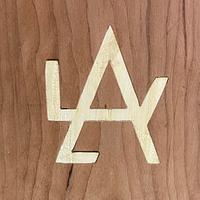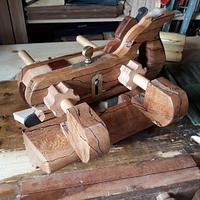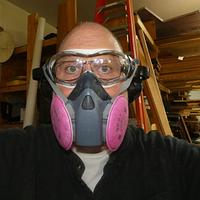
Lazyman
in about 3 years
Replacing a Chair Back Molding #2: Wood prep and milling on the CNC
This is
part 2
in a
2 part
series:
Replacing a Chair Back Molding
-
Let's do this the hard way -- Designing for the CNC
-
Wood prep and milling on the CNC
- Let's do this the hard way -- Designing for the CNC
- Wood prep and milling on the CNC
Barks side

Doesn't look like something you would salvage but it looks a little better on the Inside.

After cutting it in half it was looking doubtful but I managed to find a couple of pieces that should work. Redbud is very pretty wood.

Yeah, I should have left it in board form but I milled it into the arc shape when I was assuming I was just going to make a simple curved shape using just my band saw and some shaping by hand and on my router table.
There will be a few holes to fill but that should just add to the look.

I only had these two pieces so I decided to run some tests on some scraps so I cut and glued up a 2x4 into about the same shape as my redbud blanks.

I first had to get this mounted so that I could be sure that the entire piece would fit inside the curved blank. I used a pen holder to draw out the rough outline to make sure that I positioned it so that the entire profile would fit inside the blank. This picture is actually after the rough outline is cut but you can see the pen toolpath result.
Because of how tall the blank is, Initial work-holding required some creative clamping using some hand screw clamps. A hand screw at each end gives me a way to use hold down clamps. Note that the first step was to drill holes in the auxiliary spoil board and then drill the alignment holes into the top of the blank (which will be come the bottom of the finished molding). Initial rough outline:
Note that I will get 2 pieces of molding out of each blank. In this case two top pieces. I rough and finish carve the bottom 3D profile
Part way through the finish 3D toolpath:
The piece is then flipped over, using the alignment holes and dowels in the spoilboard to get it perfectly positioned and the bottom profile is repeated.
I now have a piece with 2 bottom profiles. I slice it in half with the bandsaw and mount it onto the spoil board using double sided tape to hold it in place, using the alignment holes to get it perfectly positioned.
And the roughing and finishing 3D toolpaths for the top are executed.


The bottom half of the molding is made from the second piece of wood and it just involves milling a profile with alignment holes but it works sort of the same way as the 3D profile. It too is milled from the top and the bottom and cut in half to yield two pieces.


It too is sliced in half and alignment holes are milled into the other side. These holes are used to join the top and bottom together. I test fit the top molding on before I sliced it in half.

You can see that there was an alignment problem when milling from the opposite side, creating a step. I fixed this for the final milling process.
All that is left is to execute the same steps on the redbud blanks.
And the top profile cut
Some shots of the finished pieces before sanding and finishing. I had to fill a few worm holes that showed up during milling.
After sanding and finishing. I used a wipe on poly.
New next to the original.
I didn't get the angle quite right as I was cutting to length and I got a little too agressive when sanding the ends but my sister is very happy.
That's it. Thanks for following along.
--Nathan, TX. Hire the lazy man. He may not do as much work but that's because he will find a better way.
14 Comments
Ryan/// ~sigh~ I blew up another bowl. Moke told me "I made the inside bigger than the outside".
working with my hands is a joy,it gives me a sense of fulfillment,somthing so many seek and so few find.-SAM MALOOF.
Resin nice touch.
Petey
May you have the day you deserve!
Steve, what I didn't show is that I actually did more than one prototype using 2x4s to hone in on the hole placement. 3rd (or was the 4th?) time was a charm.
I sure wish that Vectric would add parametric design capabilities to Vcarve. That would have made the changes between iterations much easier.
Also, when I was putting in the threaded inserts, I got one of them ever so slightly tilted in the hole (Doh!) and I had to make the matching hole in the metal back slightly larger. I briefly tried to see if I could get the insert out but decided not to risk breaking it. At that point, attaching it to the chair was all that was left and I was ready to be finished with this project.
--Nathan, TX. Hire the lazy man. He may not do as much work but that's because he will find a better way.
Excellent process and great job showing how much is involved in creating these parts.
I think the wood and prep work knock it out of the park, beautiful!
I hope those are not going to be living out in the yard!
Thanks!
--Nathan, TX. Hire the lazy man. He may not do as much work but that's because he will find a better way.
"Duck and Bob would be out doin some farming with funny hats on." chrisstef
--Nathan, TX. Hire the lazy man. He may not do as much work but that's because he will find a better way.
--Nathan, TX. Hire the lazy man. He may not do as much work but that's because he will find a better way.
MosquitoMade.com
I agree Redbud, while not seen much as lumber is always pretty, just too bad they don't get into 12" wide board size of trees. Most of them succumb to bugs, and disease rather than other issues, so finding a lot of decay is also going to be problematic.
It was Dads favorite tree, growing up I can remember a few tries of him trying to get some lumber out of a dead one. So thanks for the memory of that. :-)

















